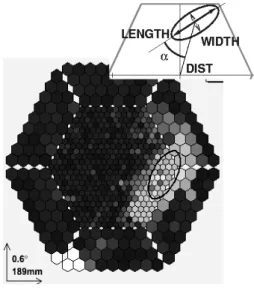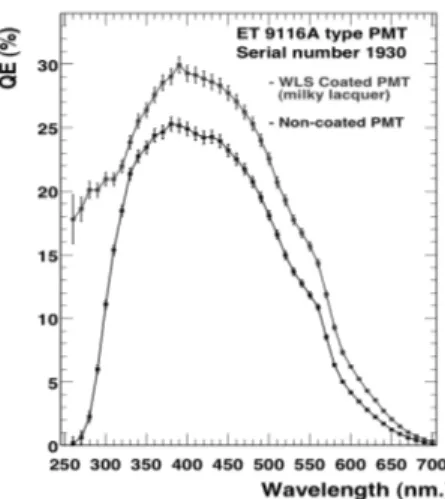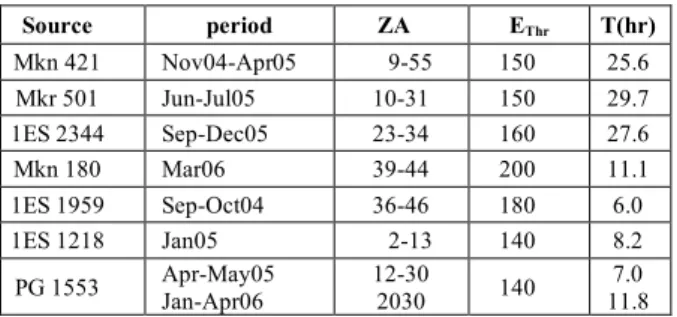1 NICOLA TURINI For the MAGIC Collaboration
University of Siena and INFN Pisa, via Roma 56 53100 Siena, Italy
The Magic Cherenkov Telescope is located at the Observatory of the Roque de los Muchachos (ORM) and since 2004 is operative, in may 2005 was started the first yearly campaign of data taking named Cycle I. During this period the telescope reported signals from galactic and extragalactic AGN sources. In this report we will describe the technique for the detection of Very High Energy (VHE) gammas by this class of experiments and the first results from Cycle I observation.
1. The MAGIC telescope 1.1. Introduction
The MAGIC telescope is a single mirror instrument designed to detect the Cherenkov light produced by the electromagnetic cascades initiated by incoming high energy gammas on the upper atmosphere [1].
The high energy gammas (50Gev-10Tev) passing through high atmosphere start an electromagnetic shower from an altitude of 15 Km. The main idea is to use the atmosphere as a giant electromagnetic calorimeter to detect the energy and the incoming direction of cosmic gammas. The shower properties are reconstructed through the detection of the Cherenkov light emitted by superluminal electrons generated in the cascade.
The light pool produced by the showers covers an area of typically 10
5/10
6m
2, such large detection area is independent from the mirror size making the Cherenkov telescopes highly sensitive. The dish area indeed is important for the detection of the lower energy gammas.
The MAGIC telescope is actually the largest telescope of this category of
instruments and therefore its energy threshold is the lowest, 50GeV, filling the
gap of the covered spectrum between satellites experiments and other VHE
gamma experiments.
The Telescope is located at an altitude of 2200 m in the area of the Observatorio del Roque de los Muchachos, in the Canary islands, covering mainly northern emisphere sources, but allowing observations also of southern emisphere candidates, as galactic center, with an higher energy threshold.
The experiment was inaugurated in October 2003 and during 2004 started commissioning runs. In may the Cycle I of observations begun allowing the detection of known and new sources.
1.2. Detection principles
The gamma primary high energy photons impinging in the upper atmosphere initiate a shower made exclusively by electron-positron couples and photons.
The large parabolic mirror telescope collect photons produced by superluminal charged particles and produce in the focus a typical image that develops in short time.
Figure 1. Typical hadron shower image on the MAGIC camera, and image parameters used to select gamma-like images.
The main source of background is generated by night sky light produced by
stars and light scattered by the atmosphere. The other main source of
background is given by showers initiated by different particles than gammas. In
particular high energy protons have a rate three order of magnitude larger than
the brightest gamma source and have a isotropic direction distribution.
The main background for the lower energy gammas is produced by large impact parameters muons that mimic gamma-like images reproducing also temporal behavior. The missing of a clear signature for low energy (<100GeV) gamma images rises the analysis energy threshold, while the trigger threshold has been measured to be well below 50GeV.
1.3. The telescope technology
The MAGIC telescope has been developed with the target of lowering the energy threshold of the instrument. For this reason new technologies had been developed during the R&D period that has been proved crucial. In particular three main issues has been exploited to reach low energy threshold: high quantum efficiency photosensors[2], large lightweight space frame and mirrors[3], low integration time in both trigger[4] and data acquisition[5].
The main dish has a mean diameter of 17m for an equivalent reflecting surface of 234m
2made by 936 0.5mX0.5m square mirrors. The mirrors are made by lightweight composite aluminum structure. The reflecting surface has been obtained milling a spherical shape on the front aluminum panel.
The other goal of the experiment is to exploit observations on Gamma Ray Burst and the entire structure has to be repositioned in a short time from the alerts coming from satellites. For this reason the structure has been made with carbon fiber tubes allowing a maximum weight of 17t. The supports are made of steel tubes and the final gross weight of the telescope is 65t.
Since the structure is not enough stiff for different zenith angles the mirror panels are focused dynamically with an Active Mirror Control system. Each panel has a laser pointer that allows to measure the off pointing and a dynamical system, based on Look Up Tables, continuously adjust each panel for different zenith angles.
The photosensors are 1 inch photomultipliers for the inner pixels and 1.5 inches tubes for the external low resolution pixels. The tubes have a semispherical entrance window to enlarge the probability of double hit of the incoming photons and a wavelength shifter coating has been added on the surface that increased the mean quantum efficiency by 30% from the original one. The same coating allowed sensitivity on the UV band as shown in fig2.
To preserve the signal integrity the transmission has been made with an
analog optical system. A VCSEL laser diode transmits the signals over 175m
from the telescope camera to the counting house, there fast receiver boards
converts back to electrical the information and prepare the signals for the trigger
and data acquisition.
Figure 2. Quantum Efficiency measurements on 1 inch Electron Tube 9116A photomultiplier. lower non coated PM, upper coated PM.
To reduce at maximum the NSB noise, the trigger performs coincidences in windows of 6ns on selectable close compact images. The DAQ is made by 300MHz samplers that acquire a time window of 30ns to fully reconstruct the original signal. Since the sampling frequency is a little marginal compared with the expected width of the shower signals, a filter has been added to stretch up to 6 ns the peaks to allow a good measurement of the absolute arrival time of the light on the tube. A double gain system has been added to increase the dynamical range of the 8 bit FADC of the samplers.
2. Cycle 1 observations Introduction
From may 2005 the telescope started an observation campaign, named Cycle1, but many hours of observations on galactic and extragalactic sources where already available from commissioning phase. The data taken since the last months of 2004, where the telescope performed almost on it’s design expectations are included in the analysis presented here.
During Cycle I where taken 750 hours of data from extragalactic sources and 500 hours from galactic sources, apart from Crab used as standard candle to calibrate the instrument.
In this phase we have monitored the performances of the telescope and
measured the energy and angular resolution. The measurements show an energy
resolution of 20% for higher energies increasing up to 35% for threshold
energies, while the spatial resolution show a PSF of ~0.1° for higher energies increasing to ~0.13° for threshold energies. The Crab plerion has been observed during winter 2004 and 2005 revealing a gamma signal at the telescope of
~20
σ/h
2.1. Extragalactic sources
The search for very high energy
γ-ray emission from Active Galactic Nuclei (AGNs) is one of the major goals for ground-based γ-ray astronomy,
The photon-photon interaction produce a cut-off for higher energies and a correlation between redshift and maximum energy of detected sources, known as Fazio-Stecker relation, is expected.
The Cycle I strategy on this category of sources was to observe a sample of X-ray bright (F
1keV>2
µJy) northern HBLs at moderate redshifts (z<0.3). The sample of candidates was chosen based on predictions from models involving an SSC and hadronic origin of the
γ-rays
In parallel with the observations of the AGNs with MAGIC, the sources were observed with the KVA 35 cm telescope, also located on La Palma. In addition to these joint campaigns, several AGNs are regularly observed as part of the Tuorla Observatory Blazar monitoring program with the Tuorla 1 m and the KVA 35 cm telescopes.
Table 1. Summary of observation of Cycle I AGN survey. ZA is the zenith angle in degrees. EThr is the analysis threshold in GeV. T(hr) is the observation time in hours.
Source period ZA EThr T(hr)
Mkn 421 Nov04-Apr05 9-55 150 25.6
Mkr 501 Jun-Jul05 10-31 150 29.7
1ES 2344 Sep-Dec05 23-34 160 27.6
Mkn 180 Mar06 39-44 200 11.1
1ES 1959 Sep-Oct04 36-46 180 6.0
1ES 1218 Jan05 2-13 140 8.2
PG 1553 Apr-May05
Jan-Apr06 12-30
2030 140 7.0
11.8
During the entire observation period Mkn 421 [6] was found to be in a low to moderate high flux state ranging from 0.5 to 2 Crab units above 200 GeV.
Significant variations of up to a factor of four overall and up to a factor two in
between successive nights has been seen and a clear correlation between X-ray
(taken from the All-Sky-Monitor on-board the RXTE satellite) and VHE
γ-raydata is verified.
Mkn 501 was observed for 24 nights (Table 1) by the MAGIC telescope.
The source was found to be in a rather low flux state during most of the observations. The flux level above 200 GeV was 30%-50% of the Crab Nebula flux with a strong indication of an IC peak. On five nights, the source was found in a flaring state with the flux reaching up to 4 Crab units Moreover, a rapid flare with a doubling time as short as 5 minutes or less was detected on the night of 10 July 2005. The rapid increase in the flux level was accompanied by a hardening of the differential spectrum. This is the first time that spectral hardening was detected on time scales of some 10 minutes. A detailed publication on the analysis and results on the observation of Mkn 501 is in preparation.
1ES 2344+514, reported a VHE
γ-rays emission by Wipple. in 1996. TheMAGIC observation of 1ES 2344+514 (Table 1) yielded a clear excess with the significance of 11.5
σ. The differential energy spectrum can be fitted by a simple power law with a photon index of 2.96 ± 0.12.
The AGN Mkn 180[7] (1ES 1133+704) is a well-known HBL at a redshift of z = 0.045. The observation of Mkn 180 was triggered by a brightening of the source in the optical on March 23, 2006, detected by the KVA telescope. The alert was given as the core flux increased by 50% from its quiescent level value.
Mkn 180 was observed by the MAGIC telescope in 2006 during 8 nights (Table 1). The signal of 165 excess events was found with a significance of 5.5
σ. No evidence for flux variability was found.. The observed integral flux above 200 GeV is 11% of the Crab Nebula flux.
1ES 1959+650[8] was observed by MAGIC during the commissioning phase in 2004 (Table 1). The analysis of the data gave a detection of VHE γ-rays on a significance of 8.2
σMAGIC observed 1ES 1218+304[9] in seven nights in January 2005 (Table 1). The observed excess of 560 events has a statistical significance of 6.4 standard deviations above 140 GeV. 1ES 1218+304 is the first source discovered by MAGIC. The gamma-ray lightcurve did not show signs of significant variability. The energy spectrum was fitted with a pure power law with a photon index of 3.0±0.4
PG 1553+113[10] was observed with the MAGIC telescope in 2005 at
about the same time as the H.E.S.S. observations took place. Motivated by a hint
of a signal in the preliminary analysis of the MAGIC data, additional
observations were performed in 2006 (Table 1). Combining the data from 2005
and 2006, a very clear signal was detected with a total significance of 8.8 σ.
2.2. Galactic sources
About 1/3 of the observation time (not counting that devoted to Crab nebula technical observations) was devoted to galactic objects. The observations covered both candidates and well established VHE
γ-ray emitters, and included the following types of objects: supernova remnants (SNRs), pulsars, pulsar wind nebulae (PWN), microquasars (µQSRs), the Galactic Center (GC), one unidentified TeV source and one cataclysmic variable. In this section we highlight the results obtained so far from such observations.
We have confirmed the VHE
γ-ray emission from the SNRs HESS J1813-178[11] and HESS J1834-087 (W41)[12].
We have also measured the VHE
γ-ray flux from the GC[13]. The possibility to indirectly detect dark matter through its annihilation into VHE
γ- rays has risen the interest to observe this region during the last years. Our observations have confirmed a point-like
γ-ray excess whose location is spatially consistent with Sgr A* as well as Sgr A East. The energy spectrum of the detected emission is well described by an unbroken power law of photon index
α= -2.2 and intensity about 10% of that of the Crab nebula flux at 1 TeV.
LS I +61 303[14] was observed in the VHE regime with MAGIC during 54 hours (after standard quality selection, discarding bad weather data) between October 2005 and March 2006
Figure 3. Smoothed maps of γ-ray excess events above 400 GeV around LS I +61 303. (A) Observations over 15.5 hours corresponding to data around periastron (i.e., between orbital phases 0.2 and 0.3). (B) Observations over 10.7 hours at orbital phase between 0.4 and 0.7.
The microquasar shows an evident pulsed VHE emission in phase with
orbital parameters. The maximum of the pulse is present between phase 0.4-0.7,
while at periastron is absent. This is the first periodic signal seen from VHE
emitters.
3. Conclusions
The magic telescope has demonstrated to work within the design specification, the analysis on the low energy gammas on the other hand has been proved difficult due to the background. Actually we are upgrading the experiment adding a mechanical clone of the MAGIC, named MAGICII. The stereo images are proven to reduce the muon background and improve the energy and direction resolution. The two telescopes design is foreseen to double the sensitivity.
The new telescope will include many new technologies as lighter 1 square meter mirrors, new photosensors and new faster samplers. The big improvement is expected by high quantum efficiency devices such as HPD’s and SiPM. A new 2GHz sampler, based on a custom chip named Domino, is foreseen to reduce the NSB contribution on the signal. The heat dissipation required by standard FADC is causing troubles and the new design will reduce it by 2 orders of magnitude.
The MAGICII telescope is expected to start it’s commissioning phase late 2007 and join MAGIC in the data taking in 2008.
Acknowledgments
We would like to thank the IAC for the excellent working conditions at the ORM in La Palma. The support of the German BMBF and MPG, the Italian INFN, the Spanish CICYT, ETH research grant TH 34/04 3, and the Polish MNiI grant 1P03D01028 is gratefully acknowledged
References



